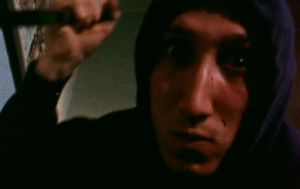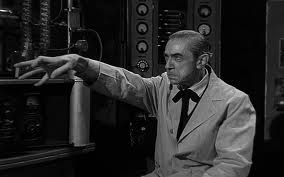Rating: 1.5/5
“You dirty, filthy pig! So, I belong with the freaks, huh? I’ll fix you so even the freaks won’t look at you.”
Sadly, because of other commitments, Movie Lottery has taken something of a back seat in recent weeks, and this will be my last post until the middle of September. However, then I will be back with a vengeance! So it is with more than a little regret that the last movie picked before this mini-sabbatical is this one: a film that has gained more notoriety because of its title than because of anything it it. The Incredibly Strange Creatures Who Stopped Living and Became Mixed Up Zombies!!? (the unconventional punctuation is officially part of the title) is a bad movie, but an altogether different kind of bad movie to those churned out by the likes of Ed Wood. Whereas his films are deliriously entertaining, this one is boring – if Ed Wood’s films are “so bad they’re good” (or, more accurately, “so bad it’s enjoyable”) then this is “so bad it’s a chore”. Yet for those willing to sit through this 82 minute endurance test, there are a few moments that make it almost worthwhile. Almost, but not quite.
Ray Dennis Steckler’s second feature does undoubtedly have one of the greatest movie titles of all time – although Asylum’s constant SyFy output now threaten to steal his thunder (or should that be Sharkthunder?). Incredibly Strange Creatures even lent its name to an influential early book on cult movies, Incredibly Strange Films, and a substantial interview with the director is included. Unfortunately, there aren’t even enough anecdotes to make this film more interesting, although I did learn that the roller coaster shown (in first person view at some points) is the Cyclone Racer in Long Beach, California – at one time the fastest dual roller coaster in the world.
Steckler is not only the film’s director; using a snazzy alias (Cash Flagg!) he is also the lead – a charisma-free layabout called Jerry. Jerry is, apparently, supposed to be a young, rebellious wild child, as indicated by his refusal to get a job and claims that the world is his university. Yet he comes across less as a free spirit, and more as an arrogant bum. Poor Steckler (or should that be Flagg?) is hardly leading man material – he doesn’t look, act, or even dress the part. Wearing a ratty navy hoodie throughout the film, this does little to add any sense of sex appeal, although it seems to serve the script somewhat by vaguely disguising him when, under hypnosis, he goes on a killing spree in full view of a room of people. It also, however, makes his tiny face look ridiculous as he’s doing it.
So, the plot. It’s probably best to not concern yourselves too much with this, as it makes no sense whatsoever. There’s a fortune teller who likes to throw acid in the faces of men who reject her advances, her sister the showgirl, a hunchback minion called Ortega, and a bevy of young, scantily clad girls. Jerry frequents the carnival with his girlfriend and friend Harold (the equally wonderfully named Atlas King, a handsome Greek actor whose accent is not helped by the film’s muffled sound quality), and they get their fortunes read. Jerry becomes fixated with the fortune teller’s sister, and then is hypnotised and turned into a murderous fiend who kills one of the other showgirls for no apparent reason. The “zombies” are not the undead risen from the grave – they are the aforementioned now-deformed suitors, who seem to have gone feral while locked in their cage (what the fortune teller was keeping them for is unclear). Their subsequent rampage following their escape lasts all of two minutes, which, coincidentally, is at least three minutes shorter than the final scene, in which Jerry is chased across the beach. It’s stupid, mundane, and very basic, filled with continuity problems and strange subplots; the dialogue is sparse (and difficult to hear); the characters fail to engage on any level.
It is, however, just one of a number of films claiming to be the first “horror musical” – it came out a mere month before one of the others, Horror of Party Beach, which, incidentally, is far more entertaining than this film. Party Beach at least attempts to integrate its music into the film; Incredibly Strange Creatures frequently takes on a revue form, with a number of musical interludes performed by ungainly, bored looking dancers and watched by an equally bored looking audience. Until the “zombie” attack, none of these serve any real purpose other than to eat into the screen time.
So, at the beginning of this review, I said there were a few moments worth watching. The main one is a fevered dream sequence following Jerry’s hypnosis. Included to indicate the poor man’s emotional turmoil, it utterly fails in this regard, but it is the strangest sequence in the movie; one that verges on the surreal, with its painted dancers and twirling graphics. In fact, the film frequently becomes almost hallucinatory in style – there are constant cuts to stock scenes of the fairground at night, with the camera dizzyingly following the tilt-a-whirls and carousels. Filmed in colour on a micro-budget (its camera operator, Vilmos Zsigmond, went on to win an Oscar for his work on Close Encounters of the Third Kind, while the assistant cameraman, Laslo Kovacs, worked on Easy Rider and numerous big Hollywood productions), the result is a head-spinning, strangely mesmerising movie – perfect for a music video perhaps, but not a narrative film. As soon as the characters reappear, the spell is broken, and once again the tedium sets in.
The final scenes offers no chance of a happy ending. Unlike the similarly low-budget movies of the 1950s, which usually culminate in the handsome man and plucky young woman embracing, here our patience is rewarded with a slowly retreating aerial shot of a group of people mournfully surrounding the body of a man that no one cared about in the first place. It’s a depressing end to an unsatisfying movie that could never even come close to living up to its absurd publicity claims (“Not For Sissies! Don’t Come if you’re Chicken! A Horrifying Movie of Weird Beauties and Shocking Monsters! 1001 Weirdest Scenes Ever!! Most Shocking Thriller of the Century!”). Is it fun to watch? No, but, as much as it pains me to admit it, even as I write I find myself thinking back with an unexpected degree of fondness. How strange. How… incredibly strange, in fact.


